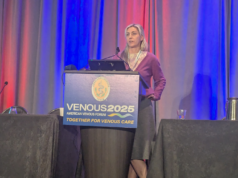A recent study has concluded that patients with inherited or acquired thrombophilia should not be excluded from ilio-femoral venous stenting, Adam Gwozdz (St Thomas’ Hospital, London, UK) reported at the European Venous Forum (EVF; 27–29 June, Zurich, Switzerland). “By all means”, Gwozdz said of the results, “we should not exclude patients with inherited or acquired thrombophilia from venous stenting.” The study gives a “very clear message” according to EVF board chairman Andrew Nicolaides, “that thrombophilia is not an independent risk factor for reintervention or stent patency loss.”
Outlining the background for the study, Gwozdz explained that ilio-femoral venous stenting in patients with thrombophilia is controversial. “We know that inherited and acquired thrombophilia increase the risk of venous thromboembolism (VTE), and in particular, the antiphospholipid syndrome (APS), which is an acquired thrombophilia, is associated with an increased risk of recurrent VTE, and has associations with arterial problems as well.”
Gwozdz and colleagues aimed to examine the association of thrombophilia with cumulative patency of reintervention rates following stenting for post-thrombotic occlusion, and included 146 patients who received a nitinol venous stent for post-thrombotic disease between 2012 and 2017. Minimum follow-up for all included patients was 18 months.
Thrombophilia testing was performed in 105 patients (76%), when VTE occurred at a younger age, with weak provoking factors, strong family history or recurrence, as per clinical guidelines. Of these patients, thrombophilia was detected in 50 (48%) with an equal split between inherited and acquired thrombophilia (25 vs. 25, respectively). The majority of inherited thrombophilia was Factor V Leiden, Gwozdz highlighted, at 72% of this subgroup.
Anticoagulation with vitamin K antagonists (VKA) was prescribed for six months, following from two weeks of post-procedural low molecular weight heparin therapy. At six months, patients with APS continued on a long-term VKA treatment plan, while all other patients switched to direct oral anticoagulant, rivaroxaban. Follow-up assessment of stent patency with duplex ultrasound was carried out at 24 hours, two weeks, six weeks, three months, six months, 12 months and annually post intervention. “We reintervened if the stent diameter reduction became greater than 50%, and this was associated with symptom recurrence” Gwozdz noted.
Reintervention rates for patients tested vs. not tested for thrombophilia, presented on a Kaplan-Meier analysis, revealed an increase in reintervention for the tested group—i.e., those patients who had met criteria for testing. However, upon closer inspection and using Kaplan-Meier analysis to compare patients with and without thrombophilia in the tested group, Gwozdz and colleagues observed “no difference” between the two groups at 30 months (15 vs. 15; p=0.646). “This is an important point”, Gwozdz highlighted, indicating that it is meeting the clinical guidelines for thrombophilia testing —rather than the actual presence of thrombophilia —that is associated with higher reintervention rates after stenting for post-thrombotic occlusion. This likely reflects the increased risk of venous thrombosis in this group of patients, and highlights that testing negative for a thrombophilia does not exclude heritable risk through as yet unrecognised mechanisms, which may contribute to a prothrombotic state.
In terms of cumulative patency, however, no significant difference was observed on Kaplan-Meier analysis between the tested and not tested group at 30 months. “So the message there,” said Gwozdz, “is that if you are vigilant and reintervene appropriately in the higher risk group of those patients meeting the criteria for testing, you will get good long-term patency.”
Outlining a set of recommendations for anticoagulation, Gwozdz maintained that if patients do meet criteria for thrombophilia testing, “the only test that makes sense from a venous stenting perspective is to test for antiphospholipid syndrome to determine which patients need to continue on long-term VKA therapy at six months ”. If a patient does not have APS, the pathway recommended by Gwozdz et al would be “very similar to those who do not have thrombophilia at all.”









